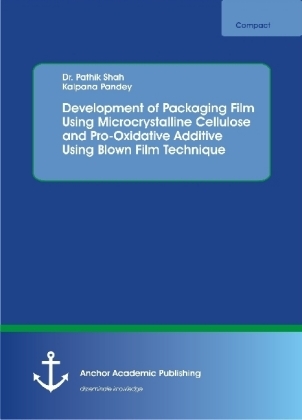
Development of Packaging Film Using Microcrystalline Cellulose and Pro-Oxidative Additive Using Blown Film Technique
Anchor Academic Publishing (Verlag)
978-3-96067-188-6 (ISBN)
Dr. Pathik Shah is working as an Assistant Professor at the Central Institute of Plastics Engineering and Technology (CIPET) in Ahmedabad, India. He has 15 years of teaching experience at various universities. Furthermore, he has published 15 international research papers and he also is a member of the editorial board as well as a reviewer of many international journals.
Text Sample:
Chapter 2.8 Biodegradation:
Biodegradation is one of the several ways of polymer may degrade in the environment. This process are also interpreted by the general public as the same as other processes of polymer degradation such, as photo degradation, oxidation and hydrolysis, though they lead to very different end products. It is often conceived that the breakdown of a plastic into small, invisible fragments is biodegradation, when in reality these fragments may remain in the environment over a significant period. Biodegradable polymers when placed in bioactive environments, such as compost, will break down to carbon dioxide and water under the action of bacteria and fungi. There are two major steps in the biodegradation process. The first one involves the depolymerisation or chain cleavage of the polymer to oligomers, and the second step is the resulting mineralization of these oligomers. The depolymerisation step normally occurs outside the microorganism and involves both endo and exoenzymes. Endo-enzymes cause random scission on the main chain, while exo-enzymes cause sequential cleavage of the terminal monomer in the polymer main chain. Once depolymerized, sufficiently small-sized oligomeric fragments are formed. These fragments are transported into the cell where they are mineralized. Mineralization is defined as the conversion of the polymers into biomass, minerals, water, CO2, CH4 and N2. There are several standard test methods available to evaluate the biodegradability of plastics as listed in. Most of these test methods measure the percent conversion of the carbon from the designed biodegradable plastics to CO2 and CH4 (plus some CO2) in aerobic and anaerobic environments, respectively. The absence of polymer and residue in the environment indicates complete biodegradation process, whereas incomplete biodegradation may leave polymer and/or residue as a result of polymer fragmentation or metabolism in the biodegradation process.
2.9 Factors Affecting Biodegradation:
Polymeric materials were subjected to degradation by biological, chemical and/or physical actions in the environment. Generally, biodegradation involves successive chemical reactions, such as hydrolysis, oxidation with/without the aid of enzymes in living organisms. The rate of biodegradation was found to be affected by several factors . Polymer's environment, organisms utilized and the nature of the polymeric materials are three main factors affecting biodegradation. All microorganisms have an optimum temperature, at which maximum growth rate occurs and thus highest enzyme kinetics exist. Discovered that an increase in the temperature of sewage in a waste water treatment plant, correlated with the increase in the rate of biodegradation of poly (hydroxylalkanoates) being tested. However, if the temperature in the environment becomes higher than the optimum temperature of a microorganism, then the denaturing of enzymes and other proteins in the microorganism takes place. In this case, the rate of biodegradation is reduced. An optimum pH value also will affect the rate of biodegradation. A microorganism also needs a certain amount of nutrients from its environment to allow it to grow. Therefore, the concentration of nutrients is essential to the rate of biodegradation. Oxygen and moisture concentration also have considerable effect on rates of biodegradation in terrestrial environments. One of the main problems in landfill sites is that there is lack of oxygen and moisture in the environment. If there is not enough moisture and oxygen in the environment, the microorganisms cannot growth. Nature of polymer substrate also affects the rate of biodegradation. Increased branching in polymeric materials will reduce the rate of degradation. Maximizing the linearity of the molecule reduces stearic hindrance facilitates the maximum susceptibility of the molecule to enzymatic attack and promotes microorganism assimilation. Low molecular plastics are su
| Erscheinungsdatum | 04.03.2022 |
|---|---|
| Sprache | englisch |
| Maße | 155 x 220 mm |
| Gewicht | 109 g |
| Themenwelt | Naturwissenschaften ► Chemie ► Anorganische Chemie |
| Technik | |
| Schlagworte | Bio Degradable • Compatibilizer • Degradable Cellulose based Packaging Film • Linear Low Density Polyethylene • LLDPE • Microcrystalline Cellulose • Packaging Film • Plastics Engineering • Pro-Oxidative Additives |
| ISBN-10 | 3-96067-188-1 / 3960671881 |
| ISBN-13 | 978-3-96067-188-6 / 9783960671886 |
| Zustand | Neuware |
| Haben Sie eine Frage zum Produkt? |
aus dem Bereich


